14 Rosette Succulents You Need in Your Collection
I absolutely love shopping online for succulents and gardening supplies. If you aren't already saving money by comparing prices online, give it a try! Here are six of my favorite things that I have purchased online as I build my own succulent oasis:
There was a time when I thought that rosette succulents were flowers. But to my surprise (and with a closer look, if I’m being honest), it’s quite clear that it is the leaves that form the gorgeous rosettes that resemble flowers.
Whether you’re new to the exciting realm of succulents, or you’ve been growing them for a while, it’s always fun to add new plants to your collection. I personally find these plants all but irresistable when I’m walking anywhere near my local garden centers.
Rosette succulents are some of the most stunning plants that you should include in your collection. These plants form rosettes with their deeply-lobed leaves and come in a variety of colors, shapes, and sizes. They may look delicate, but they can actually be quite hardy and easy to care for.
Rosette Succulent Care
The term “rosette succulent” refers to species of succulents whose leaves grow in a layered, circular pattern, giving them a look similar to a rose. Combine their decorative growth pattern with these succulents’ beautiful colors and many of them are pretty spectacular to look at! No wonder they’re a big favorite among succulent collectors.
There are loads of different rosette succulents out there. Most hail from semi-desert habitats in the Americas or Africa, sometimes at high altitudes. Rosette succulent care is pretty typical for succulents in general: they like a gritty soil mix, need water only when their soil is fully dry, and require lots of sun to thrive.
The majority of these species make a fine choice for beginners, although they’re sensitive to normal succulent problems like etiolation (stretching due to lack of light), root rot, and pests like mealybugs.
14 Rosette Succulent Types for Your Collection
In continuation, let’s have a look at some of the most beautiful rosette succulent types you might stumble upon at your local plant nursery.
Echeveria ‘Black Knight’
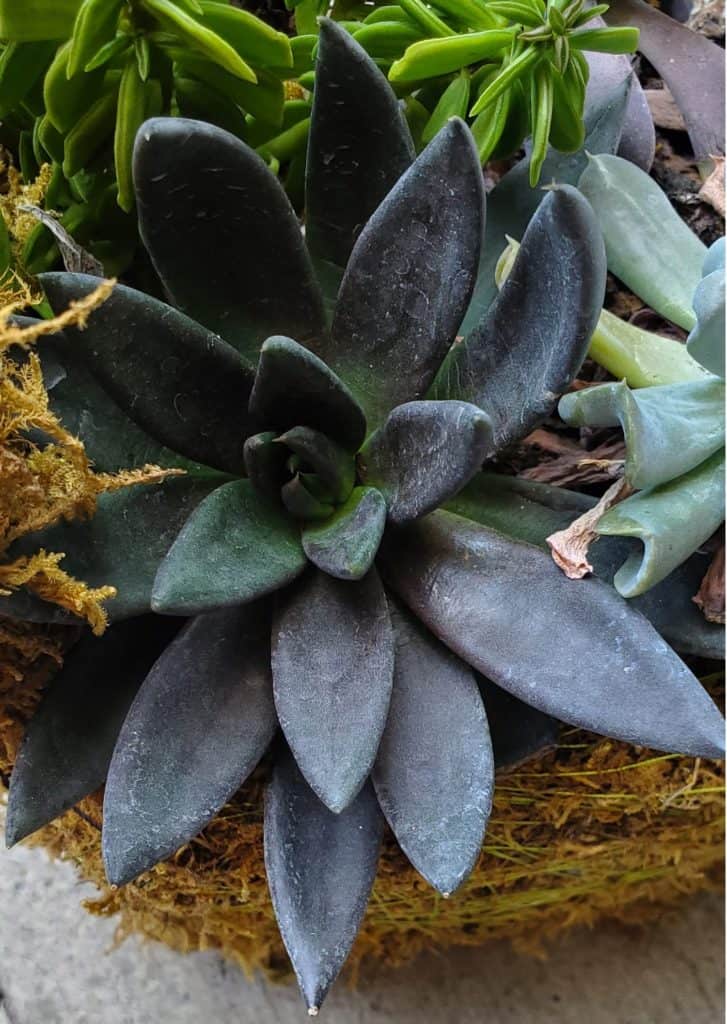
It’s only fitting to start off the list with an Echeveria. This genus contains around 150 different species and is what comes to mind for most people when they think of rosette succulents.
There are many gorgeous Echeverias out there, but one of my favorite varieties is Echeveria ‘Black Knight’. This one’s the result of selective cultivation of a species called Echeveria affinis for dark leaf color. Its leaves are almost black, with only the center of the rosette showing a bit of deep green coloration.
If you like dramatic black succulents, you may also be interested in the closely related Echeveria ‘Black Prince’, ‘Dark Moon’, ‘Dark Vader’, ‘Black Queen’, and more. These are all perfect for Halloween or a goth-themed plant collection.
Echeveria ‘Dionysos’
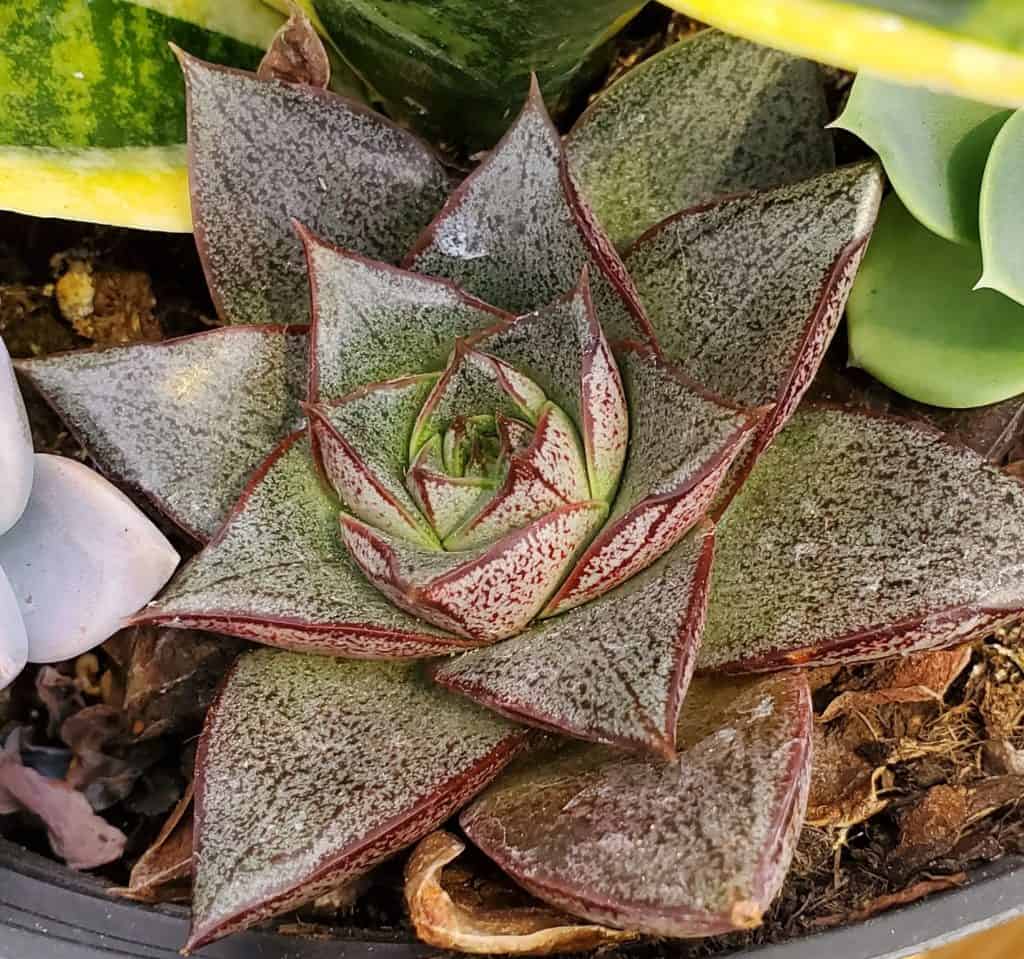
This stunning cultivar is a hybrid, the result of a cross between a species called Echeveria purpurosum and a different, unknown parent. Although its official name is Echeveria ‘Dionysos’, it’s also sometimes referred to as Echeveria ‘Bacchus’. The name pairing is not surprising, as these are the ancient Greek and Roman names for the same god (the god of the grape harvest, wine, and a good time, basically).
Its thick, pointy greyish leaves with maroon speckling and outlines have made this one of my personal favorite Echeverias! It’s not the quickest grower, but its easy care and beautiful looks make it more than worth it to me.
Echeveria Setosa
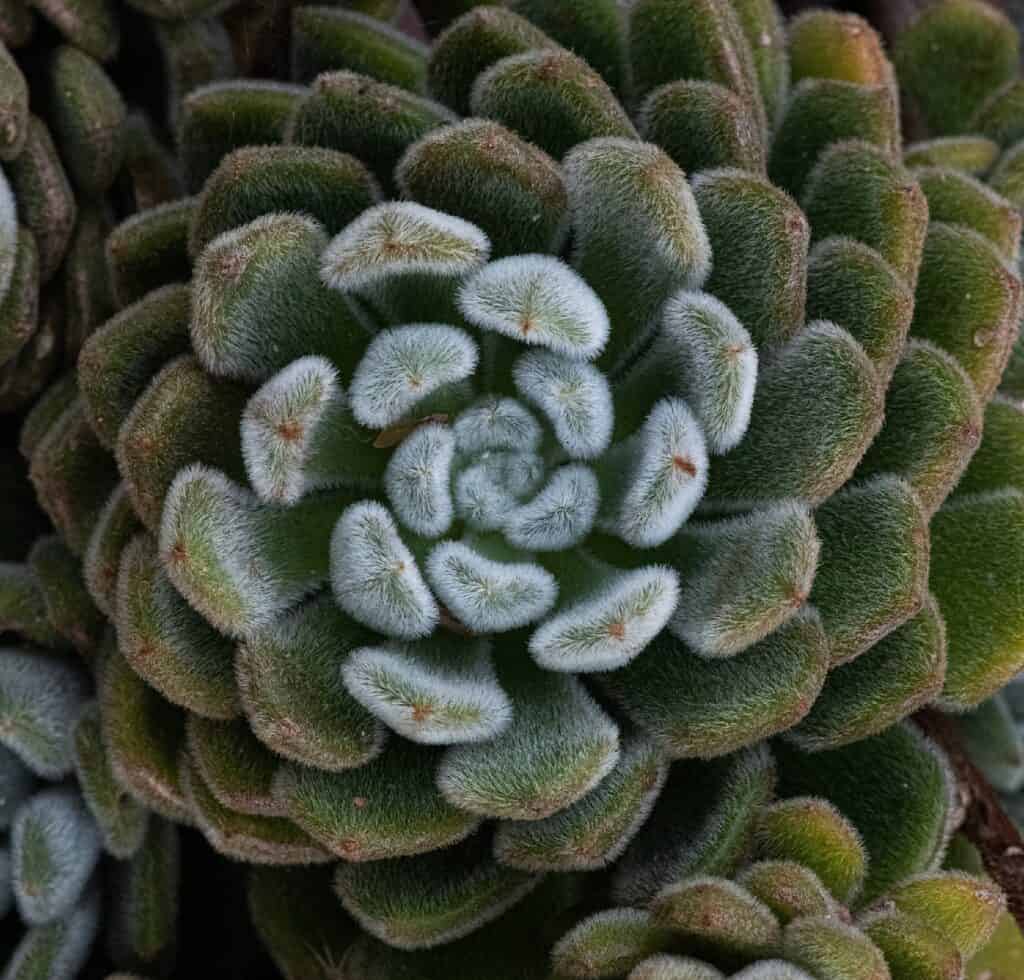
I just love fuzzy succulents, so I had to sneak one into this list of rosette succulent types as well. Meet Echeveria setosa, also known as the Mexican firecracker. Its furry leaves, whose very tips turn a brownish red when exposed to enough sun, make this one a really unique choice for your succulent collection.
If you don’t really mind a less rosette-like look, be sure to check out Echeveria setosa ‘Cristata’ as well. This is a spectacular example of a crested succulent, a mutation that turns the stems of normally circular species flat, wide, and wavy in appearance.
Related: Haworthiopsis Fasciata ‘Zebra Plant’ Care Guide
Agave Victoriae-Reginae
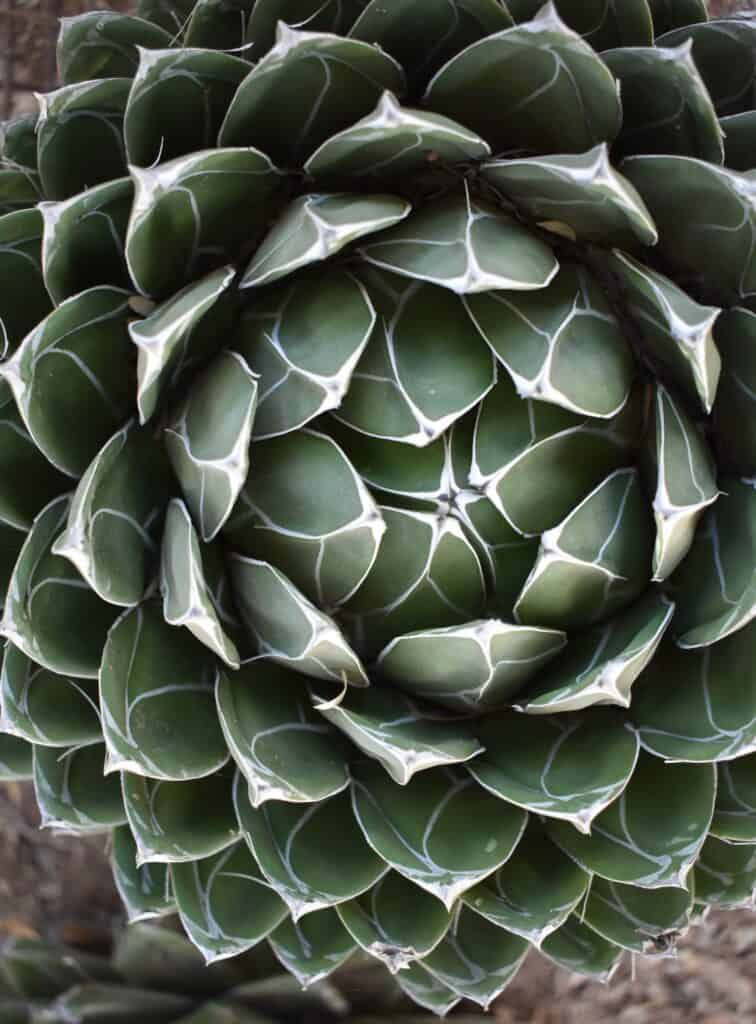
Looking for large rosette succulents to add to your collection? The genus Agave is a great choice. It contains many gorgeous species (a whopping 270, actually); but none are quite as spectacular as Agave victoriae-reginae.
Named after Queen Victoria, this Mexican native is a bit of a geometric wonder, with thick, angular green leaves and white streaks. Amazingly, there’s even a stunning variegated version out there that features a mix of deep green and yellowish-green colors. This is a slow grower, but it’s easy to keep alive as long as you give it enough sun.
Aeonium Arboreum ‘Zwartkop’
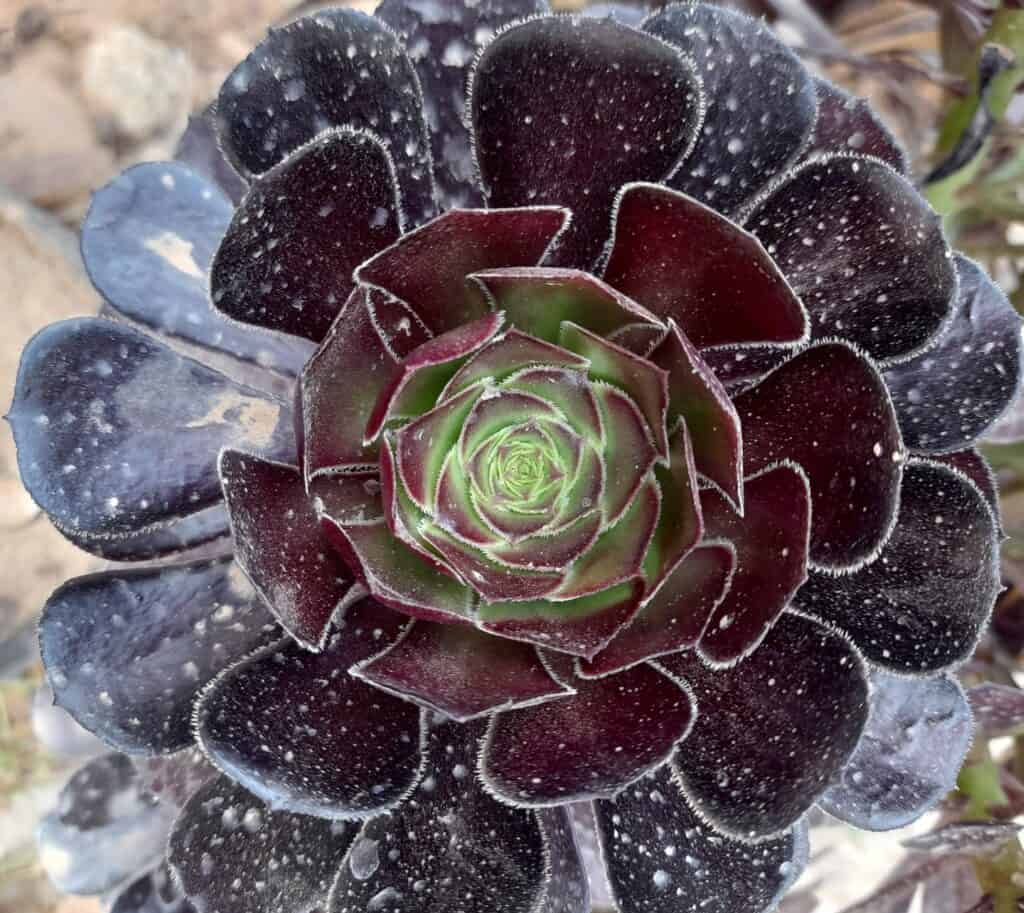
The genius Aeonium is also referred to as the tree houseleek. Unlike the succulents mentioned so far, this one’s native to the African continent, mostly the Canary Islands. It has many funky species (check out the flattest rosette succulent I’ve ever seen, Aeonium tabuliforme!), but my favorite is Aeonium arboretum ‘Zwartkop’.
‘Zwartkop’ means ‘black head’ in Dutch, and that’s pretty accurate. This beautiful succulent grows lovely reddish-black rosettes on woody stems, sometimes many on a single plant. Perfect as the tall element in a nice succulent arrangement, or just grow it on its own for a dramatic addition to your collection.
Keep an eye out for your Aeonium’s large yellow flowers, which pop up during the spring. The rosette in question will die after blooming, but no worries: it puts out plenty of offsets before kicking the bucket.
Related: Echeveria Runyonii ‘Topsy Turvy’ Care Guide
Dudleya Pulverulenta
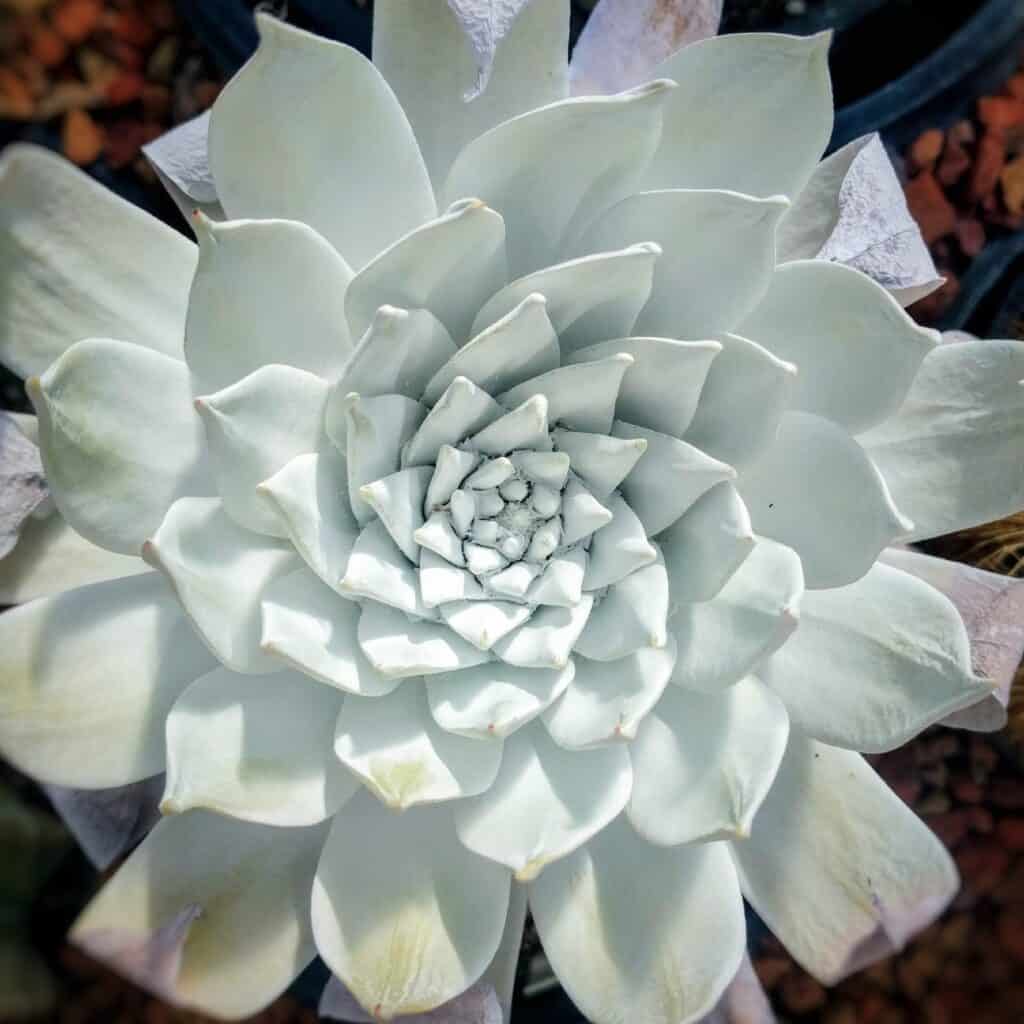
Another great option in terms of large rosette succulents is the chalk liveforever or chalk lettuce, better known as Dudleya pulverulenta. This beautiful species with long, dramatic flower spikes is naturally found in California and Baja California, where it grows on rocky cliffs and relies on hummingbirds for pollination.
Chalk liveforever rosettes can grow up to 18” wide, with relatively flat, almost ghostly blue-green leaves. Their reddish flowers pop up during late spring or early summer. Be sure to place yours outside if you live in its natural range, so local hummingbirds can enjoy the nectar! You might even get some seeds to experiment with.
Haworthia Cooperi
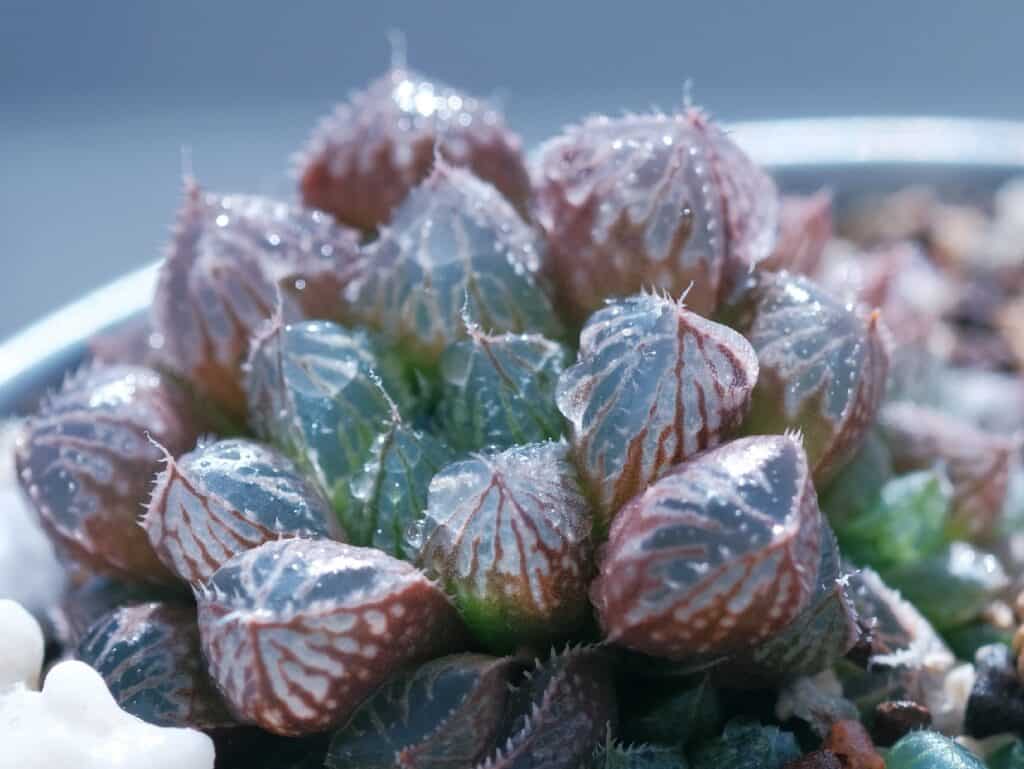
Welcome to the eccentric world of window succulents! Haworthia cooperi is incredibly popular among succulent collectors, and it’s not difficult to see why. Not only does it grow in a decorative rosette shape, but its leaves are actually somewhat translucent. This allows the species to grow partly underground in its harsh natural habitat of South Africa, a country that’s home to many of our favorite types of succulents.
Because this species is so avidly collected, a bunch of different varieties made it onto the market. Standard Haworthia cooperi has pointy leaves, but be sure to check out the round-foliaged Haworthia cooperi var. Truncata, whose leaves almost look like little bubbles. Or maybe try one of the gorgeous (though often pricey) variegated cultivars.
Related: Echeveria Shaviana ‘Pink Frills’ Care Guide
Graptopetalum Paraguayense
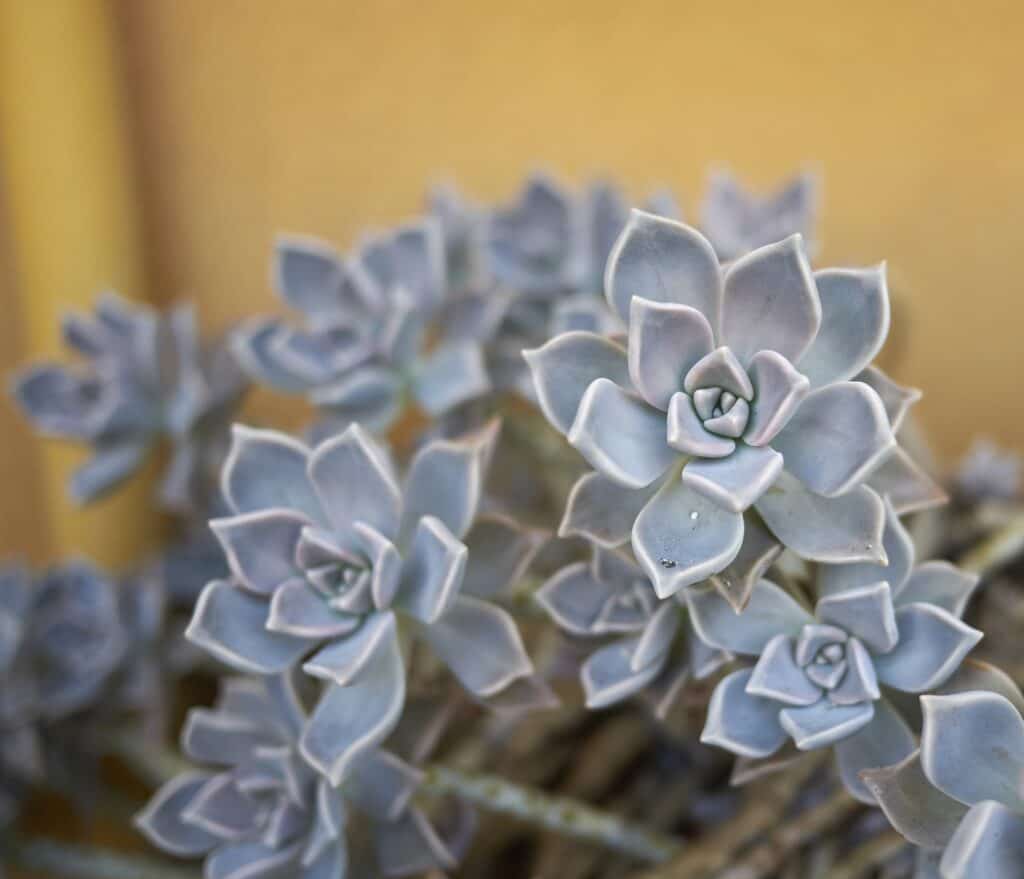
I’m a sucker for rosette succulents on long woody stems, like the aforementioned Aeonium ‘Zwartkop’. That one’s a good choice if you’re looking for a species that grows upright. If you’d like something for a hanging planter, check out Graptopetalum paraguayense instead!
Commonly known as the ghost plant, this one starts out as regular rosettes. However, as it grows, it develops a long stem that spills downward due to the weight of the leaves. I love its dramatic ‘waterfall’ effect and pleasant greyish-greenish-purplish coloration.
If you like Graptopetalum paraguayense, be sure to keep an eye out for its cultivars. I particularly like ‘Peach’ and, of course, the stripey ‘Variegata’.
Graptosedum ‘Vera Higgins’
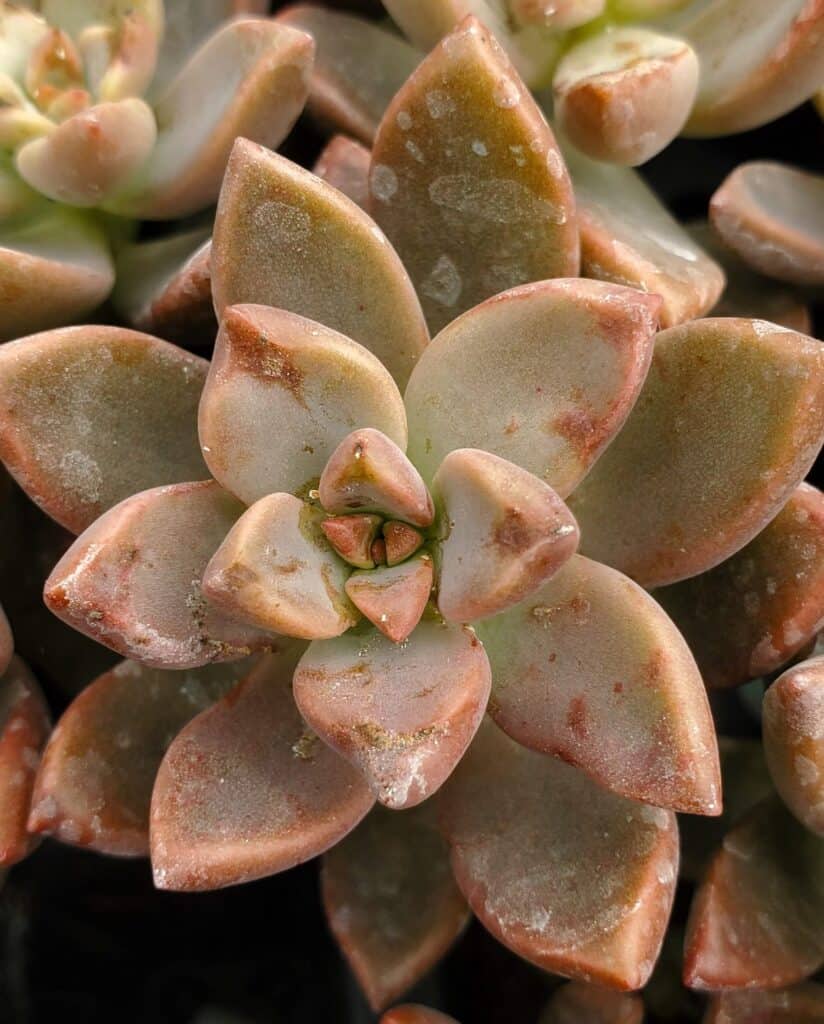
Did you know that there are a bunch of beautiful hybrid rosette succulents out there? You’ll recognize them by their compound names, which combine the parents’ own scientific denominations. One popular combination is Graptopetalum x Sedum, better known as Graptosedum.
My favorite Graptopetalum x Sedum cross is Graptosedum ‘Vera Higgins’, mainly due to its gorgeous color. The clumping rosettes are normally green with pale light-purple edges, but when exposed to enough sun, they take on a bright, orangey-red hue.
Other beautiful Graptosedums include cultivars like ‘California Sunset’, ‘Francesco Baldi’, and ‘Alpenglow’, all appreciated for their peach, reddish, and orange coloration.
Related: Echeveria ‘Marrom’ Care Guide
Graptoveria ‘Debbie’
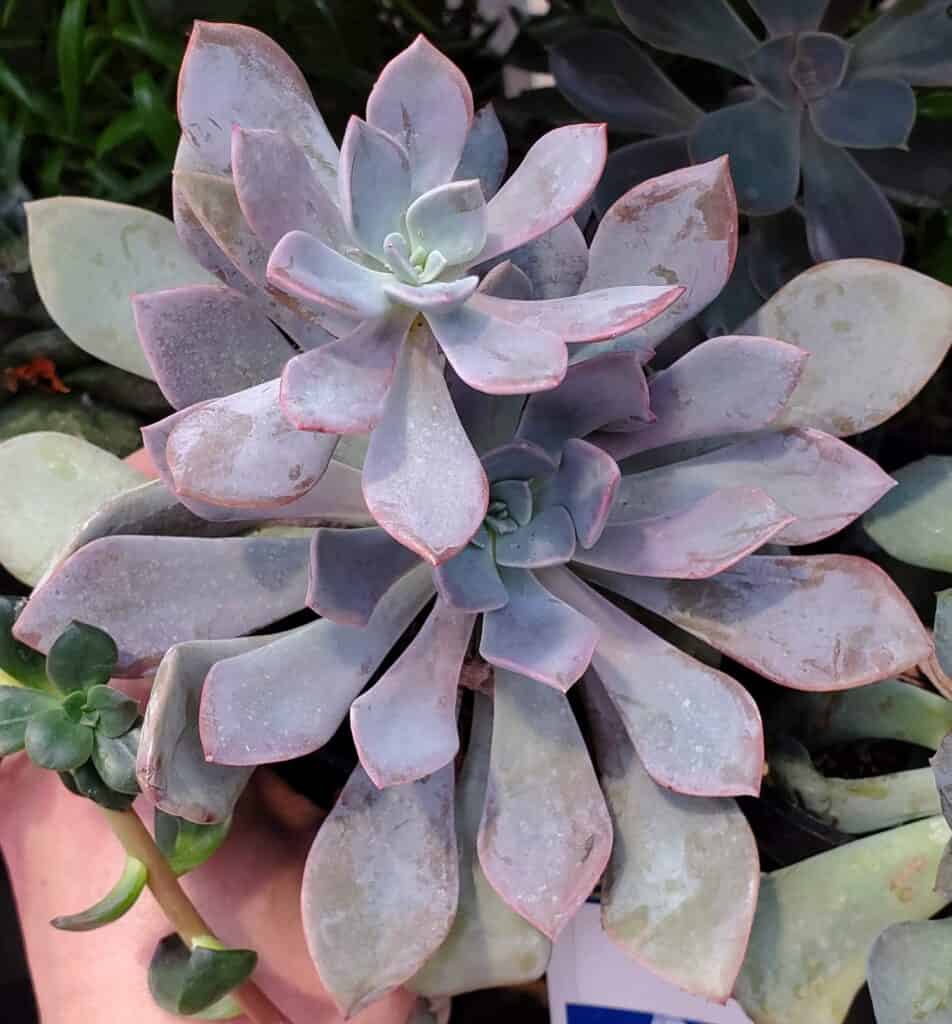
Given what you just learned about hybrid succulents, can you figure out who the parent plants are for Graptoveria ‘Debbie’ (sometimes spelled ‘Debbi’)? If you guessed Graptopetalum and Echeveria, you’re right! The Echeveria species involved doesn’t appear to be known, but the Graptopetalum parent is G. amethystinum, a fantastic little rosette succulent in its own right.
If you love beautifully colored plants, this one’s absolutely for you. Its greys, lilacs, and pinks blend together exquisitely, making for a plant that no one will manage to overlook. And let’s not even start with the variegated version, which adds creamy yellow colors to the mix. This is truly a stunner that I just can’t get enough of; it’s amazing how well two different succulent genera can go together.
Other beautiful Graptoverias include cultivars like ‘Opalina’, the green ‘Olivia’, and the ghostly ‘Fantôme’.
Pachyphytum Oviferum
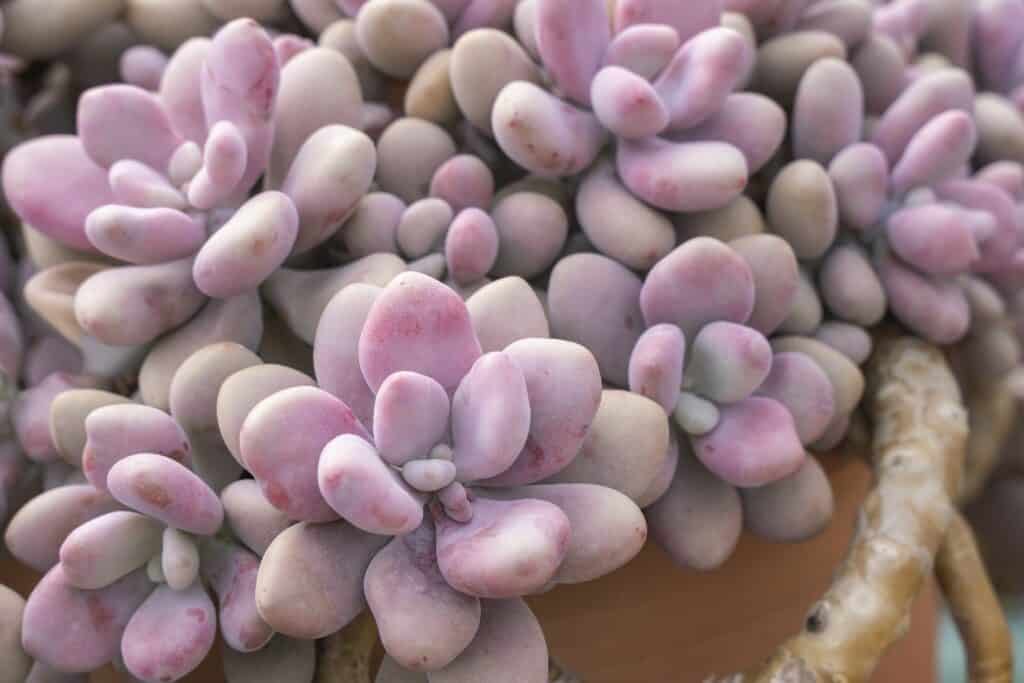
If you liked Graptopetalum amethystinum, which I briefly mentioned above, you’ll love Pachyphytum oviferum. Also known as the moonstone or mentos plant, this rosette succulent sports perfectly plump, rounded little leaves.
Although Pachyphytum oviferum is naturally a blueish grey in color, a bunch of differently colored varieties exist. Pink moonstone plants are probably the most popular, but you can also find bronze, orange, and even variegated versions! This is an ideal small, easy-care species for your rosette succulent collection.
Related: Best Succulents for Full Sun
Pachyveria ‘Blue Quartz’
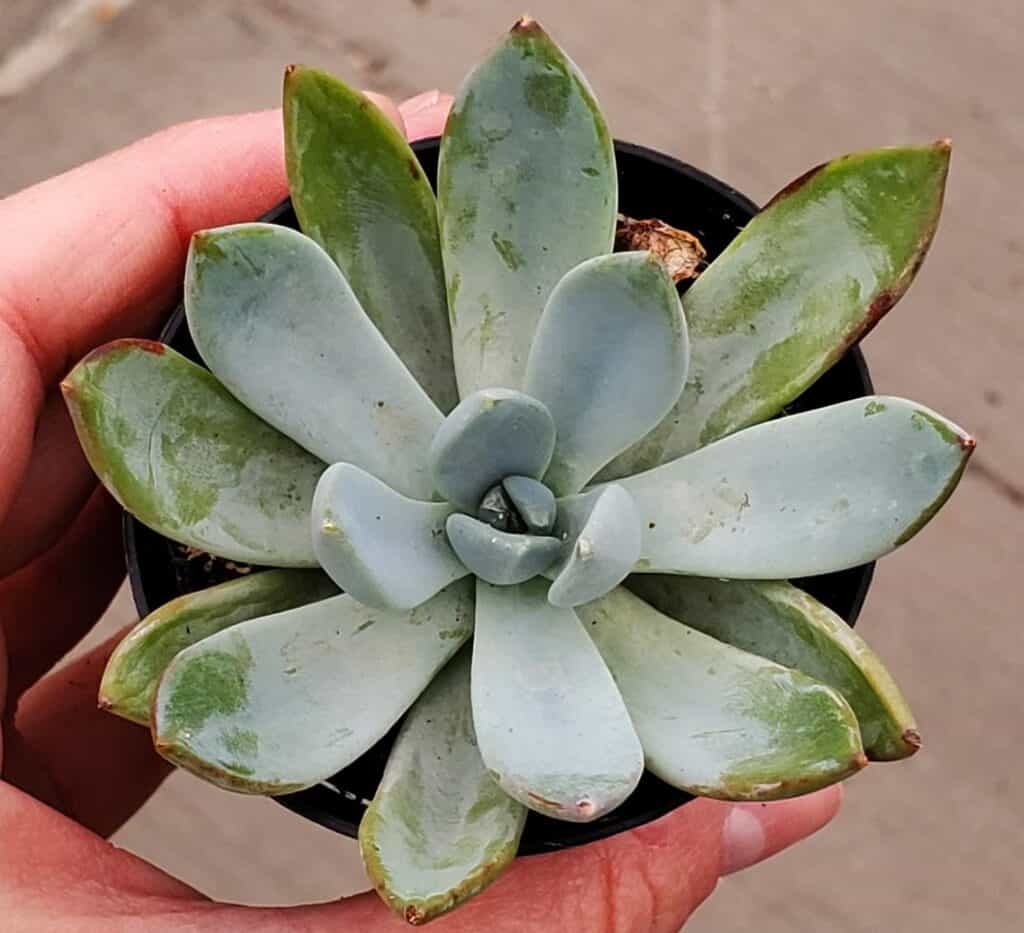
Yep, Pachyphytum and Echeveria have also been crossed. In this case, a marriage between Pachyphytum hookeri and an unknown Echeveria resulted in a plant called Pachyveria glauca. After this, P. glauca was selectively cultivated for color, resulting in a whole bunch of additional varieties. My favorite of these is Pachyveria ‘Blue Quartz’, although ‘Little Jewel’, ‘Variegata’, and others are pretty nice to look at as well.
Pachyveria ‘Blue Quartz’ is a long-leaved, powdery blue-grey clumping rosette succulent. This quick grower can develop pretty reddish tips when exposed to plenty of sun. It’s easy enough to care for, but it does appear to be a bit prone to etiolation. Give yours lots of light if you want to see it thrive.
Sedeveria ‘Blue Elf’
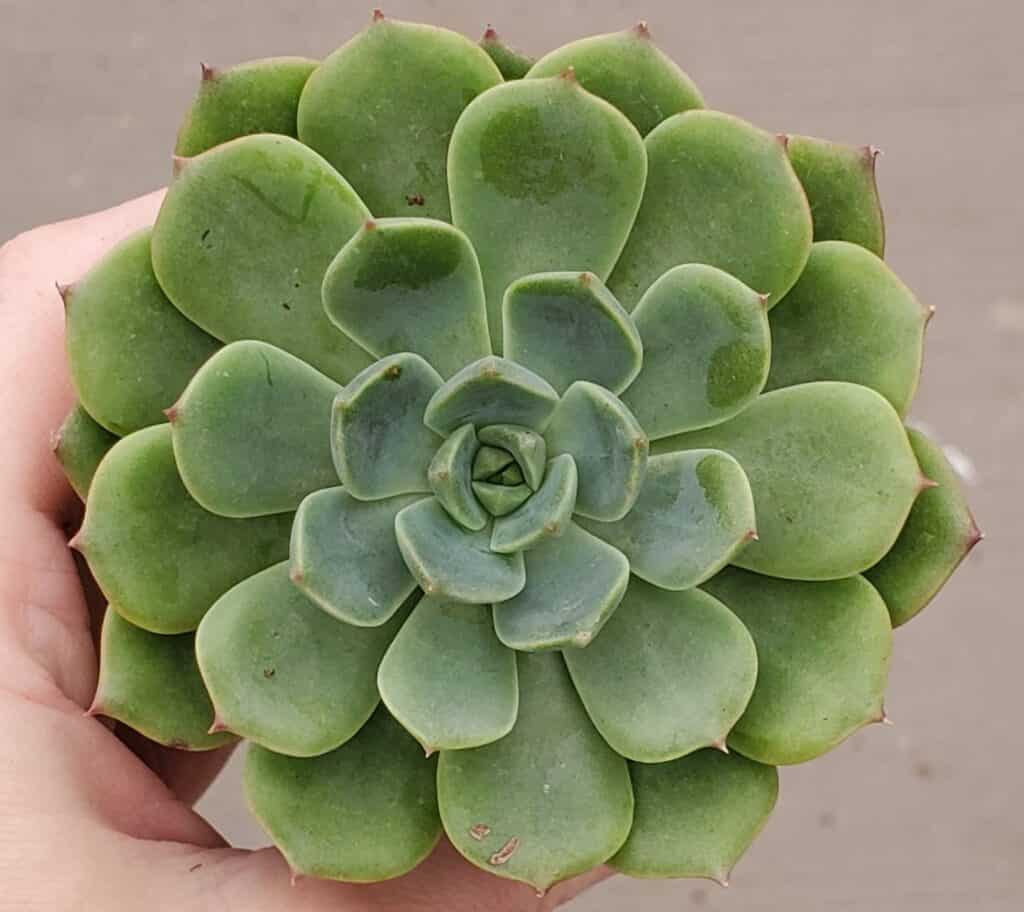
Okay, last of the hybrids! Meet Sedeveria ‘Blue Elf’, a love child between Sedum and Echeveria. This one was created by a nursery called Altman Plants, which has dozens of patented succulent varieties credited to its name, including a bunch of funky crosses.
Sedeveria ‘Blue Elf’ is a lovely rosette-forming succulent species with a multitude of upturned, orange-tipped leaves and a clumping growth pattern. It’s particularly compact and can begin to develop woody stems as it matures.
Related: Fast-Growing Succulents
Sempervivum Tectorum
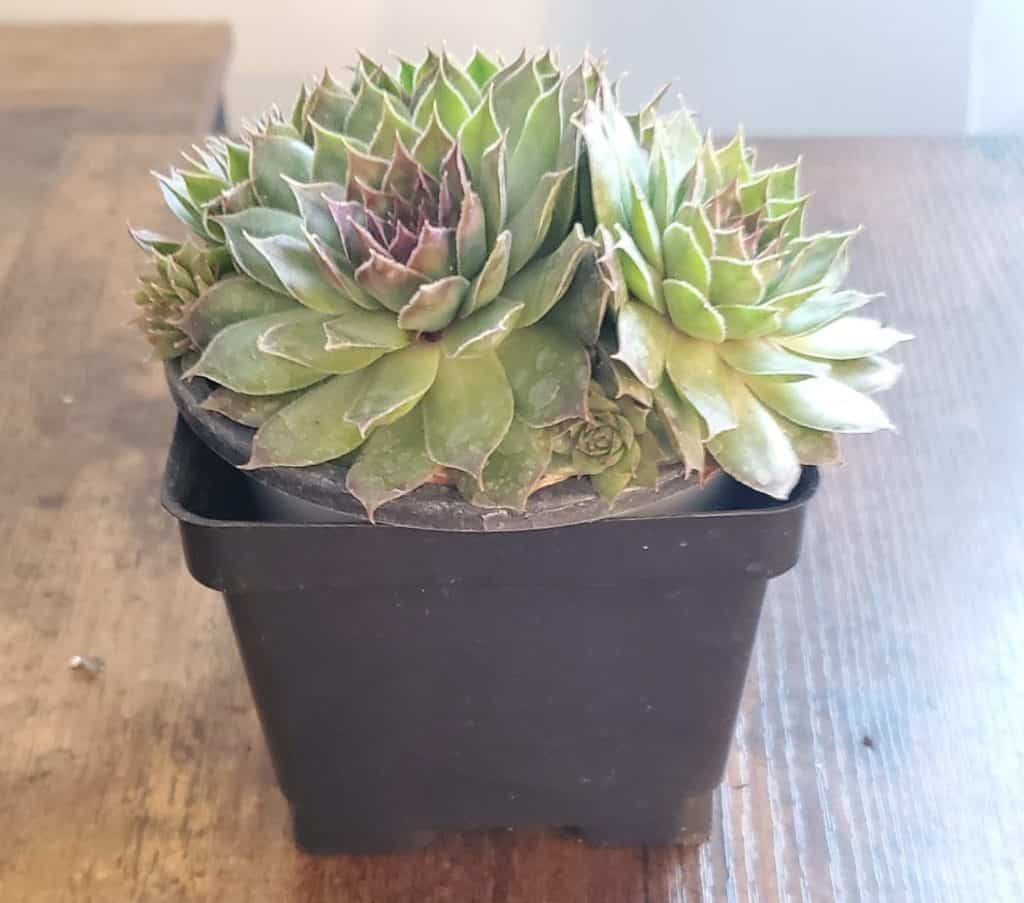
Didn’t think I was going to close out the list without mentioning a Sempervivum, did ya? If we’re talking rosette succulents, we can’t omit this ultra-hardy classic. Also known as ‘hens and chicks’ or ‘common houseleek’, it’s native to mountainous regions in southern Europe. It’s commonly grown outdoors, as it’s one of the more cold-hardy succulents out there.
Sempervivum tectorum naturally has relatively thin, fleshy green leaves with orange tips. However, plenty of cultivars exist, like the dark red ‘Emerald Empress’, red-and-green ‘Red Flush’, and many more. During summer, this species produces abundant pink, star-shaped blooms on long flower spikes, as well as lots of offsets (the ‘chicks’).
Enjoy Succulent “Blooms” All Year Round
One of the best reasons to build your collection of rosette succulents is that they appear to be in “bloom” all year long. They truly are a fun and gorgeous addition to any indoor arrangement or outdoor garden.
Once you start to fill your space with these lovely succulents with year-round rosettes, it’ll be hard to go back to your leafy greens. Enjoy the beauty and wide array of color that rosette succulent types provide.